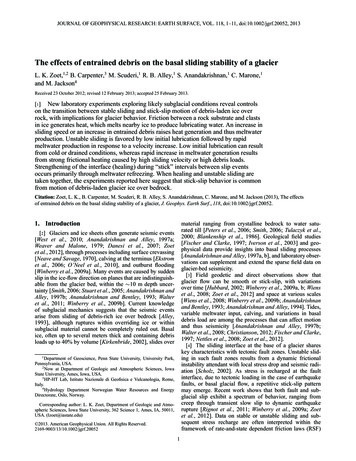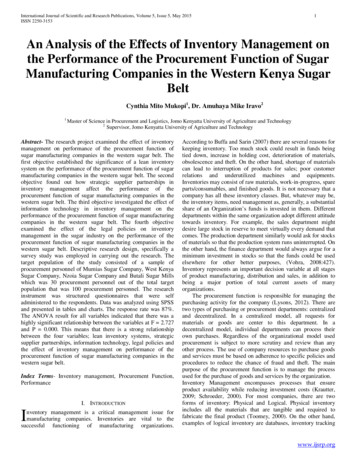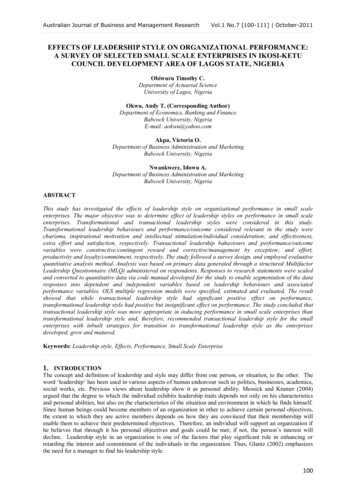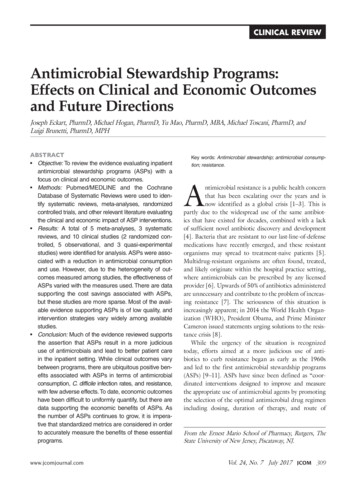
Transcription
Clinical ReviewAntimicrobial Stewardship Programs:Effects on Clinical and Economic Outcomesand Future DirectionsJoseph Eckart, PharmD, Michael Hogan, PharmD, Yu Mao, PharmD, MBA, Michael Toscani, PharmD, andLuigi Brunetti, PharmD, MPHAbstract Objective: To review the evidence evaluating inpatientantimicrobial stewardship programs (ASPs) with afocus on clinical and economic outcomes. Methods: Pubmed/MEDLINE and the CochraneDatabase of Systematic Reviews were used to identify systematic reviews, meta-analyses, randomizedcontrolled trials, and other relevant literature evaluatingthe clinical and economic impact of ASP interventions. Results: A total of 5 meta-analyses, 3 systematicreviews, and 10 clinical studies (2 randomized controlled, 5 observational, and 3 quasi-experimentalstudies) were identified for analysis. ASPs were associated with a reduction in antimicrobial consumptionand use. However, due to the heterogeneity of outcomes measured among studies, the effectiveness ofASPs varied with the measures used. There are datasupporting the cost savings associated with ASPs,but these studies are more sparse. Most of the available evidence supporting ASPs is of low quality, andintervention strategies vary widely among availablestudies. Conclusion: Much of the evidence reviewed supportsthe assertion that ASPs result in a more judicioususe of antimicrobials and lead to better patient carein the inpatient setting. While clinical outcomes varybetween programs, there are ubiquitous positive benefits associated with ASPs in terms of antimicrobialconsumption, C. difficile infection rates, and resistance,with few adverse effects. To date, economic outcomeshave been difficult to uniformly quantify, but there aredata supporting the economic benefits of ASPs. Asthe number of ASPs continues to grow, it is imperative that standardized metrics are considered in orderto accurately measure the benefits of these essentialprograms.www.jcomjournal.comKey words: Antimicrobial stewardship; antimicrobial consumption; resistance.Antimicrobial resistance is a public health concernthat has been escalating over the years and isnow identified as a global crisis [1–3]. This ispartly due to the widespread use of the same antibiotics that have existed for decades, combined with a lackof sufficient novel antibiotic discovery and development[4]. Bacteria that are resistant to our last-line-of-defensemedications have recently emerged, and these resistantorganisms may spread to treatment-naive patients [5].Multidrug-resistant organisms are often found, treated,and likely originate within the hospital practice setting,where antimicrobials can be prescribed by any licensedprovider [6]. Upwards of 50% of antibiotics administeredare unnecessary and contribute to the problem of increasing resistance [7]. The seriousness of this situation isincreasingly apparent; in 2014 the World Health Organization (WHO), President Obama, and Prime MinisterCameron issued statements urging solutions to the resistance crisis [8].While the urgency of the situation is recognizedtoday, efforts aimed at a more judicious use of antibiotics to curb resistance began as early as the 1960sand led to the first antimicrobial stewardship programs(ASPs) [9–11]. ASPs have since been defined as “coordinated interventions designed to improve and measurethe appropriate use of antimicrobial agents by promotingthe selection of the optimal antimicrobial drug regimenincluding dosing, duration of therapy, and route ofFrom the Ernest Mario School of Pharmacy, Rutgers, TheState University of New Jersey, Piscataway, NJ.Vol. 24, No. 7 July 2017 JCOM 309
antimicrobial stewardship programsadministration” [1]. The primary objectives of these typesof programs are to avoid or reduce adverse events (eg,Clostridium difficile infection) and resistance driven by ashift in minimum inhibitory concentrations (MICs) andto reverse the unnecessary economic burden caused bythe inappropriate prescribing of these agents [1].This article examines the evidence evaluating thereported effectiveness of inpatient ASPs, examining bothclinical and economic outcomes. In addition, we touchon ASP history, current status, and future directions inlight of current trends. While ASPs are expanding intothe outpatient and nursing home settings, we will limitour review here to the inpatient setting.Historical BackgroundModern antibiotics date back to the late 1930s when penicillin and sulfonamides were introduced to the medicalmarket, and resistance to these drug classes was reportedjust a few years after their introduction. The same bacterial resistance mechanisms that neutralized their efficacythen exist today, and these mechanisms continue to confer resistance among those classes [5].While “stewardship” was not described as such untilthe late 1990s [12], institutions have historically beenproactive in creating standards around antimicrobialutilization to encourage judicious use of these agents.The earliest form of tracking antibiotic use was in theform of paper charts as “antibiotic logs” [9] and “punchcards” [10] in the 1960s. The idea of a team approach tostewardship dates back to the 1970s, with the exampleof Hartford Hospital in Hartford, Connecticut, whichemployed an antimicrobial standards model run by aninfectious disease (ID) physician and clinical pharmacists[11]. In 1977, the Infectious Diseases Society of America(IDSA) released a statement that clinical pharmacists mayhave a substantial impact on patient care, including in ID,contributing to the idea that a team of physicians collaborating with pharmacists presents the best way to combatinappropriate medication use. Pharmacist involvementhas since been shown to restrict broad overutilized antimicrobial agents and reduce the rate of C. difficile infection by a significant amount [13].In 1997 the IDSA and the Society for HealthcareEpidemiology of America (SHEA) published guidelines to assist in the prevention of the growing issue ofresistance, mentioning the importance of antimicrobial stewardship [14]. A decade later they releasedjoint guidelines for ASP implementation [15], and the310 JCOM July 2017 Vol. 24, No. 7Pediatric Infectious Disease Society (PIDS) joined themin 2012 to publish a joint statement acknowledging andendorsing stewardship [16]. In 2014, the Centers of Disease Control and Prevention (CDC) recommended thatevery hospital should have an ASP. As of 1 January 2017,the Joint Commission requires an ASP as a standard foraccreditation at hospitals, critical access hospitals, andnursing care [17]. Guidelines for implementation of anASP are currently available through the IDSA and SHEA[1,16].ASP InterventionsThere are 2 main strategies that ASPs have to combatinappropriate antimicrobial use, and each has its own setof systematic interventions. These strategies are referredto as “prospective audit with intervention and feedback”and “prior authorization” [6]. Although most ASPswill incorporate these main strategies, each institutiontypically creates its own strategies and regulations independently.Prospective audit with intervention and feedbackdescribes the process of providing recommendations afterreviewing utilization and trends of antimicrobial use.This is sometimes referred to as the “back-end” intervention, in which decisions are made after antibiotics havebeen administered. Interventions that are commonlyused under this strategy include discontinuation of antibiotics due to culture data, de-escalation to drugs withnarrower spectra, IV to oral conversions, and cessation ofsurgical prophylaxis [6].Prior authorization, also referred to as a “front-end”intervention, is the process of approving medications before they are used. Interventions include a restricted formulary for antimicrobials that can be managed through apaging system or a built-in computer restriction program,as well as other guidelines and protocols for dosing andduration of therapy. Restrictions typically focus on broadspectrum antibiotics as well as the more costly drugs onformularies. These solutions reduce the need for manualintervention as technology makes it possible to createautomated restriction-based services that prevent inappropriate prescribing [6].Aside from these main techniques, other strategiesare taken to achieve the goal of attaining optimal clinicaloutcomes while limiting further antimicrobial resistanceand adverse effects. Different clinical settings have different needs, and ASPs are customized to each setting’sresources, prescribing habits, and other local specificitieswww.jcomjournal.com
Clinical Review[1]. These differences present difficulty with interpretingdiverse datasets, but certain themes arise in the literature:commonly assessed clinical outcomes of inpatient ASPsinclude hospital length of stay (LOS) and readmission,reinfection, mortality, and resistance rates. These outcomes are putatively driven by the more prudent use ofantimicrobials, particularly by decreased rates of antimicrobial consumption.ASP Team MembersWhile ASPs may differ between institutions, the staffmembers involved are typically the same, and leadership isalways an important aspect of a program. The CDC recommends that ASP leadership consist of a program leader(an ID physician) and a pharmacy leader, who co-lead theteam [18]. In addition, the Joint Commission recommends that the multidisciplinary team should include aninfection preventionist (ie, infection control and hospitalepidemiologist) and practitioner [17]; these specialistshave a role in prevention, awareness, and policy [19]. Theintegration of infection control with stewardship yields thebest results [15], as infection control aims to prevent antibiotic use altogether, while stewardship increases the quality of antibiotic regimens that are being prescribed [20].It is also beneficial to incorporate a microbiologist asan integral part of the team, responsible for performingand interpreting laboratory data (ie, cultures). Nursesshould be integrated into ASPs due to the overlap oftheir routine activities with ASP interventions [21]; otherclinicians (regardless of their infectious disease clinicalbackground), quality control, information technology,and environmental services should all collaborate inthe hospital-wide systems related to the program whereappropriate [18].Evidence ReviewTo assess the effectiveness of inpatient ASPs, we performed a literature search using Pubmed, CochraneDatabase of Systematic Reviews, and MEDLINE/OVIDSp up to 1 September 2016. The search termsused are listed in the Table. Included in this review werestudies evaluating clinical or economic outcomes relatedto inpatient ASPs; excluded were editorials, opinion pieces, articles not containing original clinical or economicASP outcome data, ASPs not performed in the inpatientsetting, and studies that were included in identifiedsystematic reviews or meta-analyses. Also excluded fromthis review were studies that reviewed ASPs performed inwww.jcomjournal.comTable. Literature Search StrategyPubmed("antibiotic stewardship") OR ("antimicrobial stewardship") OR("antibiotic management") OR ("antimicrobial management")("antibiotic stewardship") OR ("antimicrobial stewardship") OR("antibiotic management") OR ("antimicrobial management")AND (history OR historical)("antibiotic stewardship") OR ("antimicrobial stewardship") OR("antibiotic management") OR ("antimicrobial management")AND outcomes"antibiotic stewardship" AND (economics OR financial)("[antibiotic OR antimicrobial OR antibacterial] AND [stewardship]") AND (economics OR financial OR cost)("antibiotic stewardship" AND "allergy")("[antibiotic OR antimicrobial] stewardship" AND future)MEDLINE/OVIDSearch terms:(financial or cost or economics). mp.( antibiotic and stewardship) .m titl.( antimicrobial and stewardship) .m titl.("antibiotic stewardship" and evolution).mp("[antibiotic OR antimicrobial] AND stewardship" and evolution).mp.(antibiotic or antimicrobial) and resistance).mp.([antibiotic or antimicrobial] and resistance).m titl.MeSH terms: Anti-Bacterial Agents/ or *Drug Resistance, Bacterial/ or *Infection Control/ or *Bacterial Infections, *Drug Utilization/ or *Anti-Bacterial Agents/ or *Bacterial InfectionsCochrane Review("antibiotic stewardship") OR ("antimicrobial stewardship") OR("antibiotic management") OR ("antimicrobial management")niche settings or for applications in which ASPs were notyet prevalent, as assessed by the authors. The search initially yielded 182 articles. After removing duplicates andexcluded articles, 18 articles were identified for review: 8meta-analyses and systematic reviews and 10 additionalclinical studies (2 randomized controlled, 5 observational, and 3 quasi-experimental studies) evaluating clinicaland economic outcomes not contained in the identifiedaggregated studies. Systematic reviews, meta-analyses, andother studies were screened to identify any other relevantliterature not captured in the original search. The articlesincluded in this review are summarized in 2 Tables,which may be accessed at www.turner-white.com/pdf/jcom jul17 antimicrobial appendix.pdf.Vol. 24, No. 7 July 2017 JCOM 311
antimicrobial stewardship programsResultsAntimicrobial UsageThe most widely studied aspect of ASPs in the currentreview was the effect of ASP interventions on antimicrobialconsumption and use. Three systematic reviews [22–24]showed improved antibiotic prescribing practices andreduced consumption rates overall, as did several studiesinside and outside the intensive care unit (ICU) [25–31].One study found an insignificant declining usage trend[32]. An important underlying facet of this observationis that even as total antibiotic consumption decreases,certain antibiotic and antibiotic class consumption mayincrease. This is evident in several studies, which showedthat as aminoglycoside, carbapenem, and β-lactamβ-lactamase inhibitor use increased, clindamycin(1 case), glycopeptide, fluoroquinolone, and macrolideuse decreased [27,28,30]. A potential confounding factorrelating to decreased glycopeptide use in Bevilacqua etal [30] was that there was an epidemic of glycopeptideresistant enterococci during the study period, potentiallycausing prescribers to naturally avoid it. In any case, sincethe aim of ASPs is to encourage a more judicious usage ofantimicrobials, the observed decreases in consumption ofthose restricted medications is intuitive. These observations about antimicrobial consumption related to ASPsare relevant because they putatively drive improvementsin clinical outcomes, especially those related to reducedadverse events associated with these agents, such as therisk of C. difficile infection with certain drugs (eg, fluoroquinolones, clindamycin, and broad-spectrum antibiotics) and prolonged antibiotic usage [33–35]. There isevidence that these benefits are not limited to antibioticsbut extend to antifungal agents and possibly antivirals[22,27,36].Utilization, Mortality, and Infection RatesASPs typically intend to improve patient-focused clinicalparameters such as hospital LOS, hospital readmissions,mortality, and incidence of infections acquired secondary to antibiotic usage during a hospital stay, especiallyC. difficile infection. Most of the reviewed evidenceindicates that there has been no significant LOS benefitdue to stewardship interventions [24–26,32,37], andone meta-analysis noted that when overall hospital LOSwas significantly reduced, ICU-specific LOS was not[22]. Generally, there was also not a significant changein hospital readmission rates [24,26,32]. However, 2retrospective observational studies found mixed results312 JCOM July 2017 Vol. 24, No. 7for both LOS and readmission rates relative to ASP interventions; while both noted a significantly reduced LOS,one study [38] showed an all-cause readmission benefitin a fairly healthy patient population (but no benefit forreadmissions due to the specific infections of interest), andthe another [29] showed a benefit for readmissions dueto infections but an increased rate of readmissions in theintervention group overall. In this latter study, hospitalizations within the previous 3 months were significantlyhigher at baseline for the intervention group (55% vs. 46%,P 0.042), suggesting sicker patients and possibly providing an explanation for this unique observation. Even so,a meta-analysis of 5 studies found a significantly elevatedrisk of readmission associated with ASP interventions (RR1.26, 95% CI 1.02–1.57; P 0.03); the authors noted thatnon–infection-related readmissions accounted for 61%of readmissions, but this was not significantly differentbetween intervention and non-intervention arms [37].With regard to mortality, most studies found nosignificant reductions related to stewardship interventions [22,24,26,29,32]. In a prospective randomizedcontrolled trial, all reported deaths (7/160, 4.4%) werein the ASP intervention arm, but these were attributedto the severities of infection or an underlying, chronicdisease [25]. One meta-analysis, however, found thatthere were significant mortality reductions related tostewardship guidelines for empirical antibiotic treatment(OR 0.65, 95% CI 0.54–0.80, P 0.001; I2 65%) andto de-escalation of therapy based on culture results (RR0.44, 95% CI 0.30–0.66, P 0.001; I2 59%), basedon 40 and 25 studies, respectively [39]; but both results exhibited substantial heterogeneity (defined as I2 50%–90% [40]) among the relevant studies. Anothermeta-analysis found that there was no significant changein mortality related to stewardship interventions intending to improve antibiotic appropriateness (RR 0.92, 95%CI 0.69–1.2, P 0.56; I2 72%) or intending to reduceexcessive prescribing (RR 0.92, 95% CI 0.81–1.06,P 0.25; I2 0%), but that there was a significant mortality benefit associated with interventions aimed at increasing guideline compliance for pneumonia diagnoses(RR 0.89, 95% CI 0.82–0.97, P 0.005; I2 0%) [37].In the case of Schuts et al [39], search criteria specificallysought studies that assessed clinical outcomes (eg, mortality), whereas the search of Davey et al [37] focused onstudies whose aim was to improve antibiotic prescribing,with a main comparison being between restrictive andpersuasive interventions; while the difference may seemwww.jcomjournal.com
Clinical Reviewsubtle, the body of data compiled from these searchesmay characterize the ASP effect of mortality differently. No significant evidence was found to suggest thatreduced antimicrobial consumption increases mortality.Improving the use of antimicrobial agents shouldlimit collateral damage associated with their use (eg,damage to normal flora and increased resistance), andideally infections should be better managed. As previously mentioned, one of the concerns with antibioticusage (particularly fluoroquinolones, macrolides, andbroad-spectrum agents) is that collateral damage couldlead to increased rates of C. difficile infection. One metaanalysis showed no significant reduction in the rate ofC. difficile infection (as well as overall infection rate)relative to ASPs [22]; however, this finding was based ononly 3 of the 26 studies analyzed, and only 1 of those3 studies utilized restrictions for flouroquinolones andcephalosporins. An interrupted time series (ITS) studysimilarly found no significant reduction in C. difficileinfection rate [32]; however, this study was conductedin a hospital with low baseline antibiotic prescribing(it was ranked second-to-last in terms of antibioticusage among its peer institutions), inherently limitingthe risk of C. difficile infection among patients in thepre-ASP setting. In contrast to these findings, a metaanalysis specifically designed to assess the incidence ofC. difficile infection relative to stewardship programsfound a significantly reduced risk of infection based on16 studies (RR 0.48, 95% CI 0.38–0.62, P 0.001;I2 76%) [41], and the systematic
www.jcomjournal.com Vol. 24, No. 7 July 2017 JCOM 309 AbstrAct Objective:To review the evidence evaluatinginpatient antimicrobial stewardship programs (ASPs) with a focus on clinical and economic outcomes. Methods: Pubmed/MEDLINE and ntimicrobial resistance is a public health concern the Cochrane Database of that has been escala
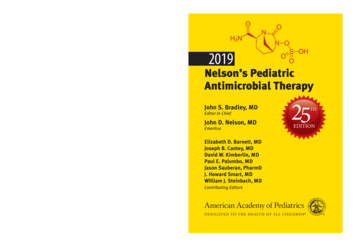



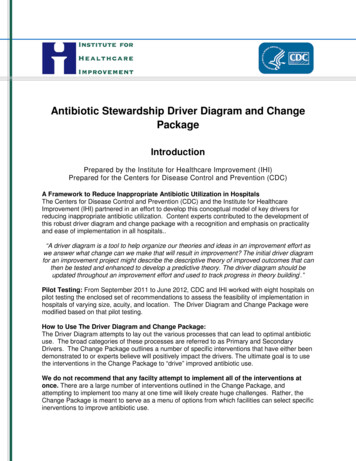

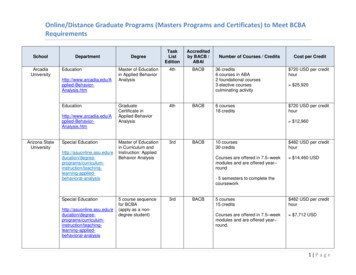
![[digital] Visual Effects and Compositing](/img/1/9780321984388.jpg)
